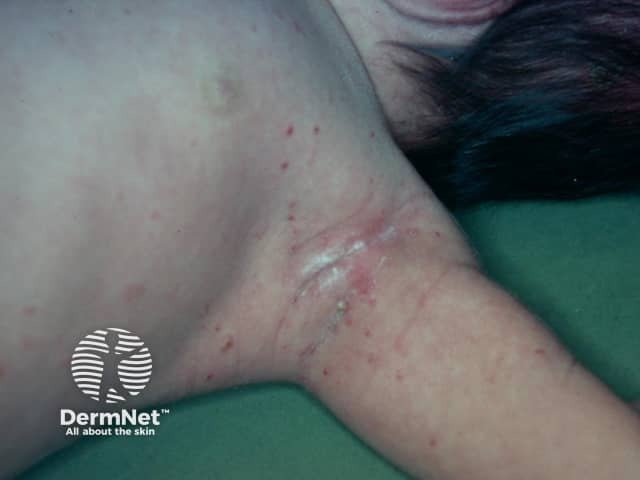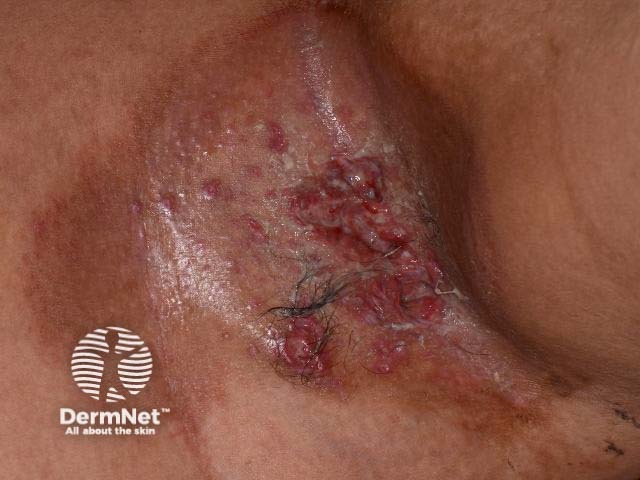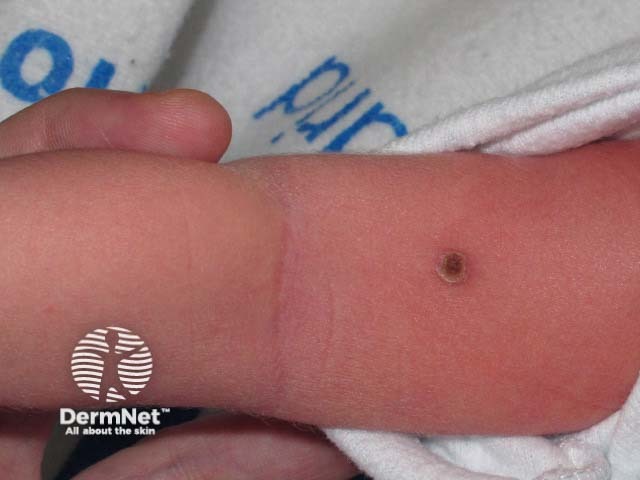Main menu
Common skin conditions

NEWS
Join DermNet PRO
Read more
Quick links
Langerhans cell histiocytosis — extra information
Langerhans cell histiocytosis
Author: Dr Amy Stanway, Dermatology Registrar, Nottingham, United Kingdom, 2005.
Introduction - Langerhans cells
Introduction
Demographics
Classification
Diagnosis
Treatment
Prognosis
What are Langerhans cells?
Langerhans cells are immune cells that are normally found within the epidermis where they act as antigen-presenting cells in an early warning system fighting foreign material such as bacteria. They may migrate to the local lymph glands but usually return to the skin.
What is Langerhans cell histiocytosis?
Langerhans cell histiocytosis (LCH) refers to a reactive increase in the number of Langerhans cells in the skin and other organs (see histiocytoses). Langerhans cell histiocytosis may also be called ‘class I histiocytosis’ or ‘histiocytosis X’.
Who gets Langerhans cell histiocytosis?
Langerhans cell histiocytosis is a rare condition, slightly more common in boys than girls, affecting around one in 5 million children and fewer adults. Langerhans cell histiocytosis may develop at any age but most commonly occurs in childhood (1–3 years of age).
How is Langerhans cell histiocytosis classified?
There is a range of ways this disease may present and some of the well-recognised patterns of this disease have been given separate names:
- Letterer-Siwe disease
- Hand-Schuller-Christian disease
- Eosinophilic granuloma
- Congenital self-healing reticulohistiocytosis.
All of these subtypes overlap and the skin disease is similar for all of them. It generally presents with many small pinkish or reddish-brown papules on the skin that may become crusted and infected.
Recent information suggests that Langerhans cell histiocytosis may be a reaction to an underlying viral infection. In at least some cases it has been associated with Epstein-Barr virus.
Letterer-Siwe disease
- Presents in very young children (usually less than two years of age)
- Involves many organs in the body including bones, lung, liver and lymph nodes
- The skin disease usually affects scalp, neck, armpits, groin and trunk
- Nails, palms and soles may be also be involved.
- Appears as pinkish small papules or blisters that may be crusted or infected
- It may look like childhood seborrhoeic dermatitis, particularly on the scalp (cradle cap)

Histiocytosis

Langerhans histiocytosis
Hand-Schuller-Christian disease
- Most commonly affects children aged 2–6 years of age
- May be very persistent
- Pinkish crusted papules on the skin in one-third
- Ulcers in the mouth or genitals
- Often results in diabetes insipidus (inability to concentrate the urine and retain water)
- Bone lesions (particularly the skull)
- Protruding eyes (rare)

Langerhans cell histiocytosis
Eosinophilic granuloma
- A limited type of Langerhans cell histiocytosis
- Mainly affects children of school age
- Usually presents as a single bone lesion
- May less commonly occur elsewhere including the skin.
- In the skin, presents as reddish-brown crusted papules.
Congenital self-healing reticulohistiocytosis
- Also known as Hashimoto-Pritzker disease
- Present at birth or develops within a few days of birth
- Presents as widespread reddish-brown lumps on the skin
- Lumps break down within a few weeks and leave crusts that heal up without any treatment.
- Does not affect other organs
How is Langerhans cell histiocytosis diagnosed?
The appearance of the rash or X-rays and scans of internal organs may give the doctor a clue to the diagnosis. A skin biopsy of the affected area is usually needed to confirm the diagnosis. The biopsy findings do not give any indication of the likely course of the disease.
The diagnosis may be obvious when the biopsy tissue is looked at under a microscope, but often special stains are needed to clearly identify the type of histiocytosis.
When histiocytosis is diagnosed in one organ (eg, the skin or bone) other organs such as the blood, lungs, liver, and kidneys are checked to determine whether they are also affected by histiocytosis.
What is the treatment for Langerhans cell histiocytosis?
Treatment depends on the severity of the disease and the number of organs that are involved. Evidence of damage to the organs is more important than involvement of the organ as such.
Disease limited to the skin only may not require treatment if mild. If treatment is necessary due to discomfort or cosmetic concerns the following treatments may be used:
- Topical corticosteroids
- Photochemotherapy (PUVA)
- Topical antiseptics and antibiotics
- Topical nitrogen mustard
- Thalidomide.
The disease affecting limited areas of the bone may be treated if causing pain or if there is a risk of deformity or fracture. The limited bone disease may be treated with:
- Non-steroidal anti-inflammatory drugs
- Steroid injections into the affected area
- Curettage (scraping out the affected area)
- Radiotherapy.
When more than one organ (eg, skin and bone) is damaged chemotherapy is usually considered. Children are usually tried on oral corticosteroids first, progressing to chemotherapy if this is ineffective. It is not clear at this time which is the most effective and safe form of chemotherapy. Decisions about chemotherapy are based on the likely long-term prognosis for an individual person.
- People who are over 2 years of age when diagnosed with histiocytosis, and who do NOT have involvement of the blood, liver, lungs or spleen are likely to do very well and may be treated with a single chemotherapy drug.
- Younger children with involvement of key organs such as the blood, liver, lungs or spleen may require more complicated chemotherapy regimens with multiple drugs.
- LCH may respond to the BRAF-V600 inhibitors, vemurafenib and dabrafenib.
Not all people with multiple organ involvement will respond to treatment.
What is the prognosis for Langerhans cell histiocytosis?
Many people may have mild disease confined to one organ with few or no symptoms. These people have a good prognosis.
Others may have more severe disease involving many organs within the body. This can be fatal. The predictors of a poor outcome are:
- Age less than two years at the onset of disease
- Disease involving many organs
- Involvement of a vital organ (blood, liver, lungs or spleen).
Children less than two years of age with LCH affecting many organs have a mortality rate of 40–50%. It is uncommon for severe LCH affecting many organs to occur in adults. People with a single affected organ or limited bone and skin disease tend to do better but the condition may still last for many years and can become worse over time.
References
- Rook's Textbook of Dermatology (7th Edition 2004), Chap 52, A Chu
- Bolognia / Jorizzo / Rapini Dermatology Mosby publishing 2003, Chap 91 by Terry Barrett and CME Goodman.
- Diamond EL, Subbiah V, Lockhart AC et al. Vemurafenib for BRAF V600-Mutant Erdheim-Chester Disease and Langerhans Cell Histiocytosis: Analysis of Data From the Histology-Independent, Phase 2, Open-label VE-BASKET Study. JAMA Oncol. 2018 Mar 1;4(3):384–8. doi: 10.1001/jamaoncol.2017.5029. PubMed PMID: 29188284; PubMed Central PMCID: PMC5844839. PubMed
On DermNet
Other websites
- Langerhans Cell Histiocytosis — Medscape Reference
